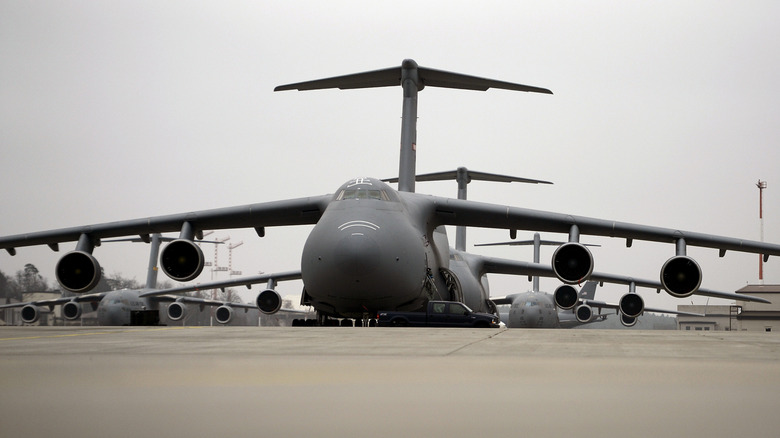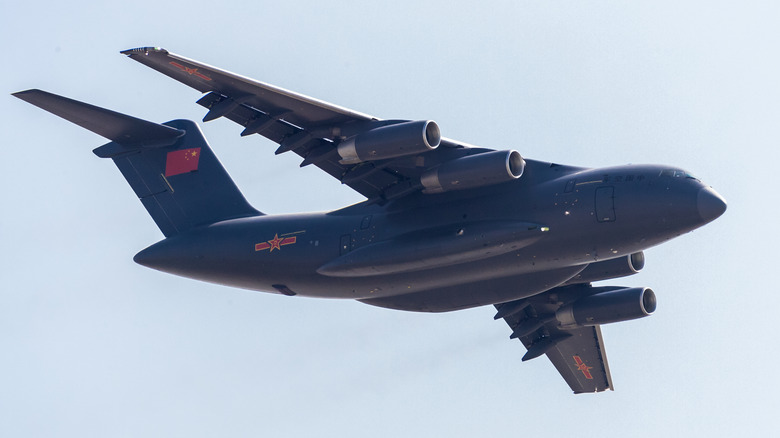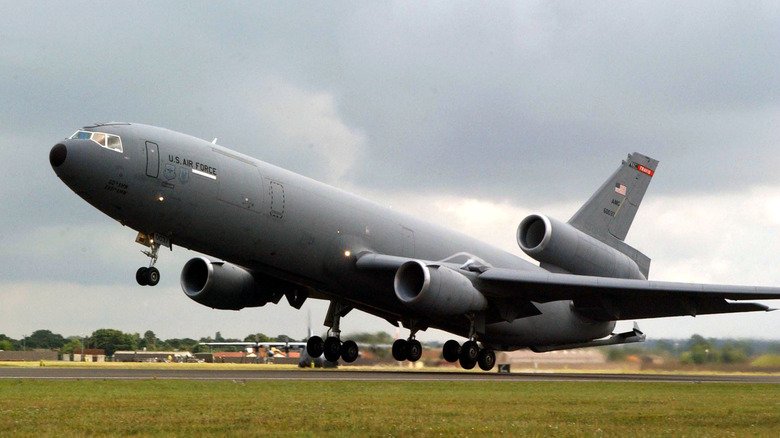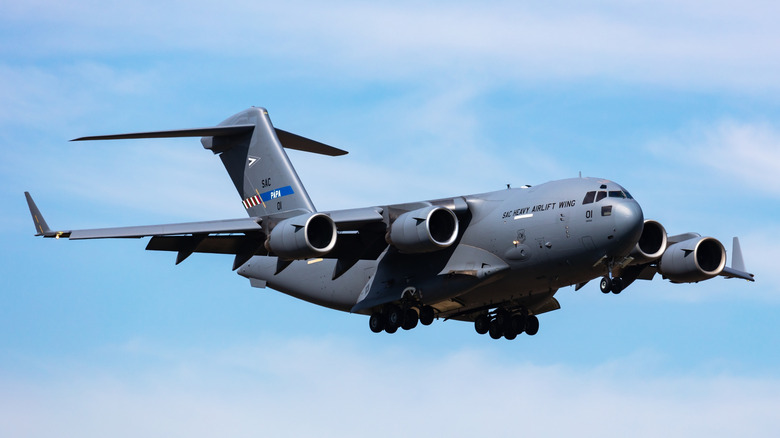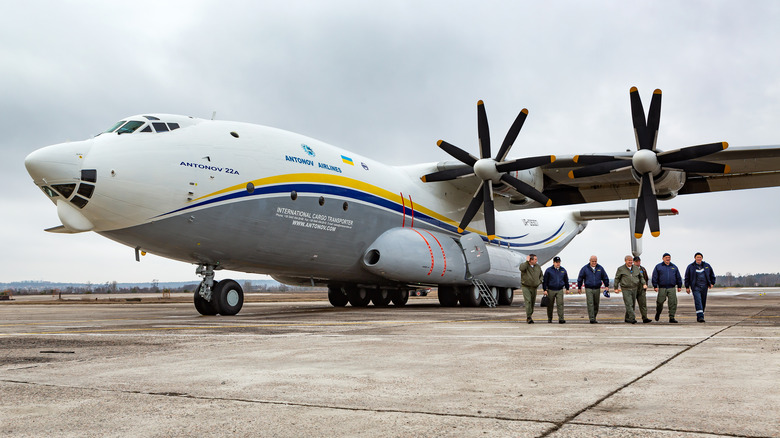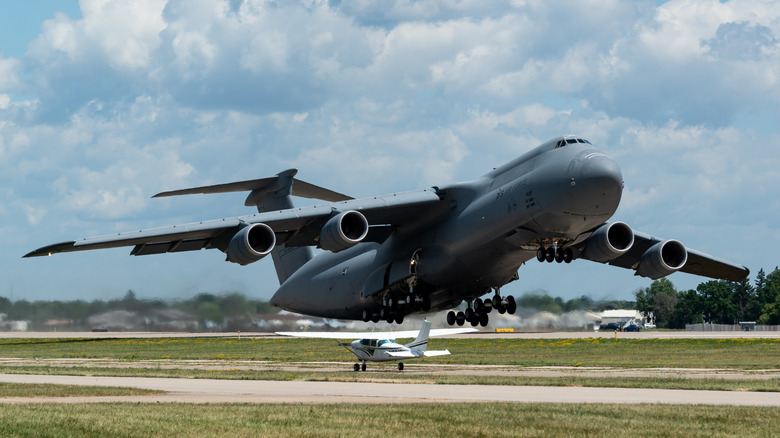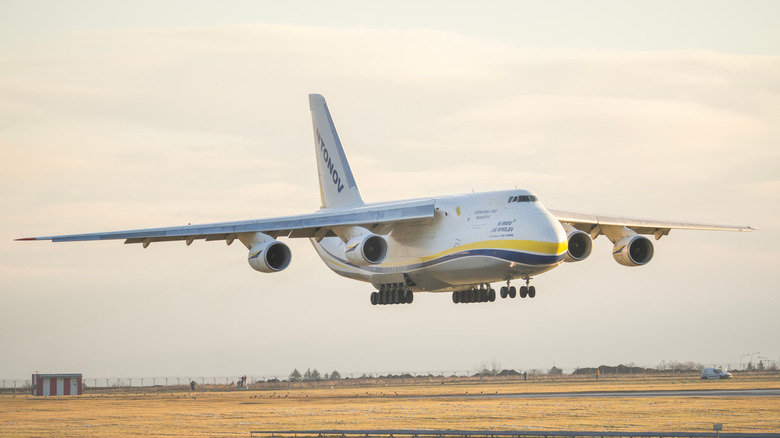Six Of The Largest Cargo Planes In Military History
Aircraft have a long and storied history of transporting goods that dates back to the earliest days of airmail. Though much like with trains and large trucks, designers quickly noted that when it comes to efficiency, bigger is better. This principle certainly applies to military applications, with some of the largest transportable armored vehicles weighing in excess of 70 tons. In order to transport as many of these goods in as few flights as possible, militaries around the world developed or adopted some truly behemoth aircraft. Some of these designs borrow heavily from civilian transport aircraft, while others are original blueprints. However, they all share a common trait: they move staggering amounts of goods.
The practice of building such dedicated transport aircraft dates back to the 1921 Vickers Vernon, with 55 production aircraft based on the Vickers Vimy bomber. The Vimy and its derivatives feature a gross takeoff weight of approximately 12,500 pounds — light enough that the largest aircraft on this list could theoretically transport half of all Vernons produced (with their cargo) in one flight.
Typically, operators field a variety of different transports to suit the specific flight parameters. The aircraft on this list represent cargo transportation at the strategic level — that is, moving the absolute largest amount of goods between two points. And they are utterly unparalleled at this specialized task. Let's take a look at each and their respective cargo capacities, from least to greatest.
Xian Y-20 Kupeng – 145,505 pounds
The Xian Y-20 represents by far the most recent aircraft on this list, with its first flight out of Shaanxi in January 2013. Not to mention that the Y-20 is a dramatic technological leap forward for China, being their first dedicated strategic cargo aircraft (their primary lifter beforehand being the An-12-derived Shaanxi Y-8). The Y-20 boasts 3D-printed composites in its construction and a highly flexible design architecture, configurable into various naval and aerial roles.
According to the World Air Forces Directory, 34 of these aircraft currently serve with the PLA Air Force for a total combined cargo capacity of 2,474 tons. Supplementing the Y-8 and Y-9 medium transport fleet with up to 30 tons of capacity, the Y-20 provides the Chinese air force with previously unheard-of levels of payload flexibility.
The Xian Y-20 also steps up China's level of self-sufficiency within aviation, utilizing composite materials manufactured indigenously. According to the ODIN Army database, these materials are reportedly on-par with FAR Part 25 Airworthiness Standards for Transport Category Airplanes, providing a healthy compromise between strength and airframe weight-savings. This design helps shave down the weight sufficiently to carry enough fuel for a 4,211 nautical-mile flight, easily sufficient to transit all of China with cargo. This effectively monopolizes its role of long-range transport, being the only such aircraft in service with China.
The Y-20's development was plagued with controversy, however. Its general shape is frequently cited as a "knockoff" of American designs, largely citing the information leaks sent to China at the time. Still, while it's not as large or powerful as other aircraft on this list, its construction methods and payload are certainly more than noteworthy (for better or worse).
McDonnell Douglas KC-10 Extender – 170,000 pounds
Normally well-regarded for its in-air refueling duties, the KC-10 Extender completed its last flight for the U.S. Air Force in September 2024, though it remains in-service with Omega Air Refueling. These aircraft are conversions of the civilian DC-10 passenger airliner, developed to meet a demand for a platform with greater capabilities than the KC-135. The KC-10 typically operates as a refueler, though it actually boasts a great deal of flexibility. According to the U.S. Air Force's fact sheet, this venerable airframe saw service as a cargo transport, airborne ambulance during aeromedical evacuations, and passenger aircraft with room for 75 troops.
It first entered service in 1981, though over the years, many systems were modernized. These include the usual upgrades such as the avionics suite, as well as more specialized tools such as a variety of refueling components like wing-mounted pods. The venerable KC-10 truly found its place in the 1990s, serving across Desert Shield and Desert Storm. It performed with distinction in this theater, delivering 125 million gallons of fuel without missing a single scheduled rendezvous, along with various cargo operations.
Being the only aircraft originally intended for in-air refueling on this list, the KC-10's mission profile is inherently more diverse than other dedicated cargo aircraft. However, that certainly doesn't take away from its formidable payload capacity of 85 tons — far exceeding even the KC-46A's capacity of just 33.25 tons. Plus, given the nature of the aircraft, its operational range is utterly unmatched in terms of moving goods from point A to B. Frequently, KC-10s operate with multirole missions, such as refueling fighters while carrying a payload of equipment.
McDonnell Douglas/Boeing C-17 Globemaster III – 170,900 pounds
Though the main selling point of the C-17 is its flexibility, this certainly doesn't detract from its massive carrying capacity of 85.5 tons. The Globemaster III was designed after the prototype McDonnell Douglas YC-15, intended to replace the outgoing C-130 Hercules. Following a number of trials and competitions, the U.S. Air Force selected this platform and designated it "C-17," leading to a number of iterations and improvements until we get to the present day. It went through a long, complicated, and difficult development cycle, with a number of issues such as buckling wings under stress leading to redesigns of entire sections of its structure.
The modern C-17 Globemaster III's mission primarily revolves around moving cargo to remote destinations, ideally as close to the front as is feasible. Its rigorous design criteria combined a heavy cargo transporter with minimal takeoff and landing distances, a difficult engineering challenge to say the least. According to official records, such distances were as little as 2,570 feet to land with a total weight of 468,900 pounds.
This capability affords the C-17 a level of operational capability which is entirely unmatched by anything short of a Chinook. However, unlike a rotary-wing aircraft, the C-17 can carry an Abrams tank, 10 Humvees, or 100 troops in a single sortie. Essentially, if you somehow combine the capabilities of something like a bush airplane and a 747, you get a C-17. Although it can't carry outright as much as some of the aircraft on this list, the Globemaster III will carry its payload to just about anywhere with a few thousand feet of flat (or flat enough) ground.
Antonov An-22 Antei – 176,370 pounds
Just about the only platform on this list that can truly exceed the Globemaster III in terms of its takeoff and landing capability, the An-22 holds the distinction of being the world's largest turboprop aircraft, as well as the first wide-body transporter. The massive An-22 first took flight on February 27, 1965, and immediately set 41 turboprop records, some of which have never been broken.
Although it may seem a bit odd to produce such a behemoth of an aircraft as a turboprop, this actually makes a great deal of sense. The USSR was a vast country, with massive swathes being nothing but fields and farmland. Transporting huge quantities of supplies to such remote destinations required either a train or an aircraft, leading to the development of some truly monstrous platforms like the An-22 or the Mil V-12.
In comparison to jets, turboprops offer advantages in takeoff and landing performance, especially with straight-wing designs which excel at short-distance requirements (hence why virtually all STOL bush planes are straight-wing). Essentially, the An-22 was the definition of an aircraft of its time, which through its utterly excessive levels of capability, provided it with a level of relevance for an incredible 70 years.
The An-22 features four Kuznetsov NK-12 turboprops, each turning two contra-rotating propellers similar to the Tu-95. The massive thrust they provide will launch the platform into the air after just 4,265 feet — less than half that of a Boeing 737-900. This provides a level of lifting performance virtually unmatched in turboprop aircraft, making the An-22 one of the best short-medium range, heavy-cargo transporters flying today. Sadly, the sole remaining Ukraine-operated An-22 suffered heavy damage following the Battle of Antonov Airport, along with the destruction of the iconic An-225.
Lockheed C-5M Super Galaxy – 281,001 pounds
Representing by far and away the heaviest lifter of the United States, the Lockheed C-5M Super Galaxy is an absolute beast of an aircraft. First produced in 1968, the C-5 series met the U.S. requirements for a cargo jet capable of transporting oversize equipment that aircraft like the C-141 Starlifter couldn't. And the C-5 excelled at this task, with over 35,000 cubic feet of usable cargo space in comparison to the C-141B's 9,190 cubic feet.
Since the U.S. accepted their first C-5 in 1969, the airframe has received a number of modernizations, most notably the installation of new wings in the 1980s and engines in 2006. The new General Electric F138 is a variant of the CF6, an engine which powers a number of airliners including the Airbus Beluga, KC-10, and 747-400. The engines help shave down takeoff and landing distances, as well as increase cargo capacity and range. Along with an avionics modernization package, aircraft so-equipped are known as the C-5M Super Galaxy.
With these upgrades in-place, the C-5M moves 60 tons of cargo over 5,500 nautical miles, boasts a maximum capacity of 140.5 tons, and requires just shy of 5,000 feet of runway to land safely fully-loaded. Whereas the U.S. Air Force employs the C-17 to carry heavy loads across theaters, the C-5M carries those loads across continents. Currently, this aircraft represents the single most expensive piece of equipment to maintain in the entire U.S. inventory. That said, it easily justifies the astronomical cost with its (nearly) unparalleled capability in hauling the heaviest and most oversize loads that the U.S. Armed Forces requires.
Antonov An-124-100M-150 Ruslan – 330,693 pounds
It should come as no surprise to aviation enthusiasts that the largest military cargo aircraft was produced by Antonov. This company has a habit of designing large, rugged airframes; from the venerable An-2 Colt to the An-225 Mriya, both of which need no introduction. Likewise, the Antonov An-124 is a similarly-proportioned monstrosity of an airframe, bearing the single highest tonnage of cargo capacity of any serial-production aircraft in history.
Originally, the An-124 was limited to "just" 132 tons of capacity, with Antonov increasing the payload to over a staggering 165 tons. This program involved strengthening the braking system, fuselage structure, cargo ramp, and cargo deck floor, providing up to 150,000 kg (approximately 330,695 lbs) of payload. Coupled with a modernization package, this gives us the full name of Antonov An-124-100M-150 — denoting the An-124-100 fitted with modern avionics and the upgraded payload capacity. The "100" in the name classifies a commercial variant, as opposed to the An-124 which is a military aircraft.
The military career of the An-124 began on December 24, 1982, following its first flight. Its main purpose was similar to the C-5 Galaxy's in that it was designed to shuttle oversize loads between military hubs. Its original design criteria set forth by the CPSU Central Committee called for an aircraft with a maximum payload of 100-120 tons — the An-124 easily exceeded their request. After the fall of the USSR, it continued service with civilian logistics companies and Antonov themselves. Antonov operates seven An-124s as of 2019, with two of them fitted with the modernization and payload packages. The An-124 also continues its Russian service, with most aircraft flying today fielded by the Russian Air Force.
